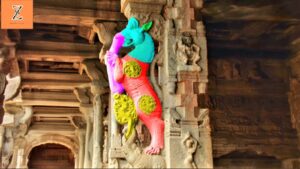7 Secrets of Virupaksha Temple Hampi: That Will Leave You Awestruck

Nestled in the heart of Hampi, the Virupaksha Temple is a timeless masterpiece dedicated to Lord Shiva, revered as Virupaksheshwara, and his consort, Goddess Parvati, known here as Pampa Devi. This ancient temple is not merely a place of worship but a symbol of Hampi’s rich cultural and spiritual heritage, steeped in myths, architectural brilliance, and celestial mysteries.
1. The Mythological Essence

The name Virupaksha stems from the Sanskrit words Virupa (deformed) and Aksha (eye), referring to Shiva’s third eye. Legend has it that Shiva, in a state of deep meditation after the loss of his beloved wife, Goddess Sati, was interrupted by Kama Deva (the god of love). Kama’s arrow aimed to reignite Shiva’s affection, but instead provoked his wrath. Shiva’s third eye opened, reducing Kama to ashes. This poignant tale not only explains the temple’s name but also symbolizes love’s transcendence through spirituality, as Kama was later restored in a non-physical form at the behest of his wife, Rati.

Adjacent to the temple lies the sacred Manmatha Theertha, a pond believed to have formed from the melting rocks where Kama Deva’s essence flowed. Pilgrims visit this site to absolve their sins, further deepening the temple’s spiritual allure.
2. The Divine Wedding

Virupaksha Temple is also linked to the celestial union of Lord Shiva and Goddess Parvati, who were married here under the title Girija Kalyana. The temple’s main Shiva Linga, a self-manifested (Swayambhoo) idol, is believed to have emerged at the exact spot where this divine wedding took place. Surrounding the temple are several structures commemorating their union, including the Phala Pooja Mandapa, where their engagement ceremony is said to have occurred.
3. Architectural Marvels

The temple complex, a blend of Dravidian and Vijayanagara styles, was constructed by various rulers over centuries. Its most striking feature is the towering eastern gopura, or gateway, known as Bistappaya Gopura, soaring to an impressive height. This pyramid-like structure showcases intricate carvings and sculptures that narrate mythological stories.
Behind this primary gateway stands the smaller Rayara Gopura, constructed during the reign of Krishnadevaraya, a prominent Vijayanagara king. Inside the temple, the Sabha Mandapa (gathering hall) with its intricately carved pillars and Kalyana Mandapa (wedding hall) adorned with frescoes further accentuate the temple’s grandeur.
4. Inverted Shadow Mystery

One of the most astonishing aspects of Virupaksha Temple is its enigmatic inverted shadow phenomenon. The shadow of the main tower is projected upside down on a wall in the Saalu Mandapa, roughly 30 meters away. This occurs through a natural pinhole effect, showcasing the ancient engineers’ advanced understanding of optics. What makes this feature even more fascinating is the shadow’s consistency—it remains unchanged in size or position throughout the day, displaying different hues in the morning, afternoon, and evening.
5. The Five Sacred Pedestals

The temple complex includes five significant structures, collectively known as Pancha Peeta:
- Deepa Stambha: A towering lamp post symbolizing enlightenment.
- Istarthi Sidhi Linga: The wishing stone believed to fulfill devotees’ desires within a year.
- Naivedya Peeta: A pedestal for offering sacred food.
- Dhvajastambha: The flagpole marking the temple’s sanctity.
- Nandi Mandapa: A pavilion housing three unique Nandi statues, representing the Trimurti—Brahma, Vishnu, and Shiva.
These pedestals form the heart of the temple’s rituals, including the daily Thrikala Puja (three-time worship), which highlights its spiritual vibrance.
6. Artistic Legacy

The temple walls and ceilings are adorned with vibrant paintings depicting scenes from the Mahabharata, the ten avatars of Vishnu, the coronation of Krishnadevaraya, and, most importantly, the divine wedding of Shiva and Parvati. Remarkably, these artworks retain their brilliance, created from natural dyes derived from fruits, flowers, and plant extracts.

Another noteworthy carving is that of Gajayali, a mythical animal combining the features of six creatures: a horse for speed, a lion for strength, a fox for cunning, a peacock for beauty, and an elephant for cultural significance. This composite symbol reflects the Vijayanagara dynasty’s multifaceted ethos.
7. Rituals and Offerings
The temple is a bustling center of devotion, offering free meals (anna prasada) to visitors daily. Pilgrims perform special rites, including a cradle service at the Mukthi Narasimha Swami Temple, believed to bless couples with children.
Market Ruins and Historical Significance

In front of the temple lies the Hampi Bazaar, once a thriving marketplace attracting traders from Europe, the Middle East, and Asia. This bustling hub showcased the Vijayanagara Empire’s prosperity, trading in diamonds, gold, and horses. Today, its ruins whisper tales of a glorious past.
Read also: 15 Must-Visit Ancient Temples in Hampi: That will Shock You!
Read also: 10 Must-Know Secrets of Hampi for an Unforgettable Adventure
Conclusion
Virupaksha Temple is more than an architectural marvel; it is a living testament to India’s spiritual legacy, an ode to divine love, and a symbol of ancient engineering prowess. Whether you visit to uncover its mysteries or seek solace in its sanctity, this temple promises an unforgettable journey through history and divinity.


1 thought on “7 Secrets of Virupaksha Temple Hampi: That Will Leave You Awestruck”